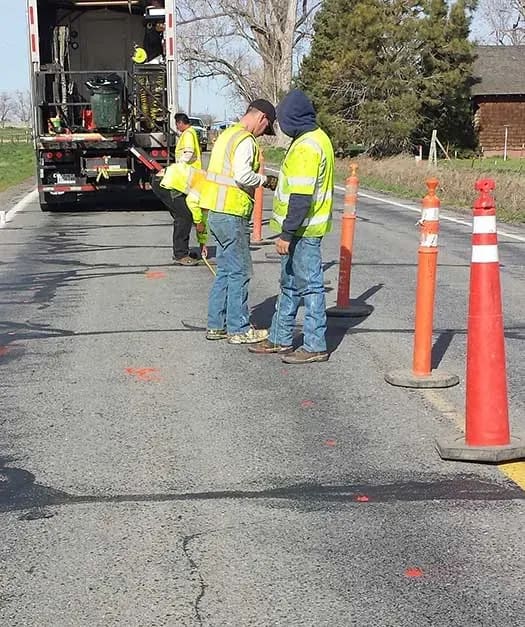Rut Vicinity Injection Increases Bearing Capacity in Idaho
Problem
A portion of an asphalt roadway in Filer, Idaho (East 3110 N.) had become rutted due to insufficient bearing capacity and increased industrial/farm equipment traffic. However, the Filer Highway District had a limited budget to address the situation. The Filer Highway District hired URETEK to develop and test a new, cost-effective method to increase the bearing capacity of the rutted asphalt roadway. URETEK conceived a variation of its standard URETEK Deep Injection® (UDI) protocol for soil stabilization that they called Rut Vicinity Injection (RVI). The RVI protocol was tested at the Filer site.
Analysis
In investigating this new RVI protocol, URETEK was focused on two main research areas. First, would the RVI protocol improve bearing capacity? If so, RVI would be a feasible protocol. Second, if RVI was proven to be feasible, what would be the optimal quantity of polymer per injection?
Solution
The test site consisted of two control sections (Sections 1 and 7) and five test sections (Sections 2-6) along the rutted roadway. The subgrade type was clayey sand (SC). The control sections were not injected with any polymer in order to form a baseline measurement, and the test sections were injected with varying amounts of polymer. Each of the ruts in the test sections were injected in 12 locations spaced at three-foot intervals. (To reduce polymer consumption, URETEK tested a shallow injection pattern.) Test Section 2 was injected until the pavement registered movement upwards indicating maximum polymer injection quantity. Test Sections 3-6 were injected until the predetermined poundage for each injection hole was reached.
Result
After injections were completed, an independent geotechnical engineering firm performed Falling Weight Deflectometer (FWD) testing and analysis. They reported an increase in Pavement Support System (PSS) stiffness for every injected test section. Moreover, the results clarified the optimal amount of polymer to inject for stiffening the PSS at this site. Injecting the optimal polymer amount yielded a 38.8% increase in PSS stiffness over the control. Therefore, URETEK was able to prove that RVI is economical, feasible, and effective! Thanks to URETEK’s thorough investigation, the Filer Highway District was able to reap the benefits of the new RVI technique to repair its rutted asphalt roadway.
URETEK Deep Injection® (UDI)
Widely referenced throughout our industry, UDI involves the injection of structural polymer into base and subgrade soils to increase the load bearing capacity. This is achieved by injecting the polymer through small holes drilled directly through the pavement structure to depths determined by site-specific analysis. Our URETEK 486 Star® material flows easily into voids and weak zones within the soil mass below. Through a controlled chemical reaction, the expanding polymer compacts surrounding soils and applies a controlled pressure on targeted areas of the affected pavement above. If needed, a multi-injection design plan is utilized to gently return the pavement to its original grade. The composite material quickly cures into a strong, dimensionally stable, and water-resistant geo-material, providing years of reliable service.
URETEK 486 Star®
URETEK 486 Star® polymer is a two-component, high-density, expanding thermoset polyurethane system. It was developed to be the ideal solution for under-sealing, void filling, lifting of settled pavement, stabilization and stiffening of weak soils, and for encapsulating and sealing buried infrastructure. URETEK 486 Star® is environmentally inert, non-toxic, and resists underground water erosion or weakening due to its industry-leading hydrophobic properties.


